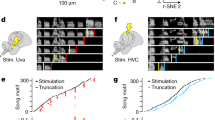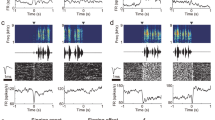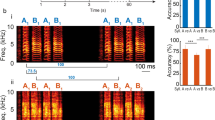Abstract
Many complex behaviours, like speech or music, have a hierarchical organization with structure on many timescales, but it is not known how the brain controls the timing of behavioural sequences, or whether different circuits control different timescales of the behaviour. Here we address these issues by using temperature to manipulate the biophysical dynamics in different regions of the songbird forebrain involved in song production. We find that cooling the premotor nucleus HVC (formerly known as the high vocal centre) slows song speed across all timescales by up to 45 per cent but only slightly alters the acoustic structure, whereas cooling the downstream motor nucleus RA (robust nucleus of the arcopallium) has no observable effect on song timing. Our observations suggest that dynamics within HVC are involved in the control of song timing, perhaps through a chain-like organization. Local manipulation of brain temperature should be broadly applicable to the identification of neural circuitry that controls the timing of behavioural sequences and, more generally, to the study of the origin and role of oscillatory and other forms of brain dynamics in neural systems.
This is a preview of subscription content, access via your institution
Access options
Subscribe to this journal
Receive 51 print issues and online access
$199.00 per year
only $3.90 per issue
Buy this article
- Purchase on Springer Link
- Instant access to full article PDF
Prices may be subject to local taxes which are calculated during checkout





Similar content being viewed by others
References
Marder, E. & Bucher, D. Understanding circuit dynamics using the stomatogastric nervous system of lobsters and crabs. Annu. Rev. Physiol. 69, 291–316 (2007)
Stent, G. S. et al. Neuronal generation of the leech swimming movement. Science 200, 1348–1357 (1978)
Williams, H. Birdsong and singing behavior. Ann. NY Acad. Sci. 1016, 1–30 (2004)
Konishi, M. Birdsong: from behavior to neuron. Annu. Rev. Neurosci. 8, 125–170 (1985)
Nottebohm, F., Stokes, T. M. & Leonard, C. M. Central control of song in the canary, Serinus canarius. J. Comp. Neurol. 165, 457–486 (1976)
Nottebohm, F., Kelley, D. B. & Paton, J. A. Connections of vocal control nuclei in the canary telencephalon. J. Comp. Neurol. 207, 344–357 (1982)
Zann, R. A. The Zebra Finch: A Synthesis of Field and Laboratory Studies 196–246 (Oxford Univ. Press, 1996)
Glaze, C. M. & Troyer, T. W. Temporal structure in zebra finch song: implications for motor coding. J. Neurosci. 26, 991–1005 (2006)
Cooper, B. G. & Goller, F. Physiological insights into the social-context-dependent changes in the rhythm of the song motor program. J. Neurophysiol. 95, 3798–3809 (2006)
Sossinka, R. & Böhner, J. Song types in the zebra finch (Poephila guttata castanotis). Z. Tierpsychol. 53, 123–132 (1980)
Vicario, D. S. Organization of the zebra finch song control system: II. Functional organization of outputs from nucleus Robustus archistriatalis. J. Comp. Neurol. 309, 486–494 (1991)
Wild, J. M. Descending projections of the songbird nucleus robustus archistriatalis. J. Comp. Neurol. 338, 225–241 (1993)
Vu, E. T., Mazurek, M. E. & Kuo, Y. C. Identification of a forebrain motor programming network for the learned song of zebra finches. J. Neurosci. 14, 6924–6934 (1994)
Yu, A. C. & Margoliash, D. Temporal hierarchical control of singing in birds. Science 273, 1871–1875 (1996)
Solis, M. M. & Perkel, D. J. Rhythmic activity in a forebrain vocal control nucleus in vitro . J. Neurosci. 25, 2811–2822 (2005)
Chi, Z. & Margoliash, D. Temporal precision and temporal drift in brain and behavior of zebra finch song. Neuron 32, 899–910 (2001)
Laje, R. & Mindlin, G. B. Diversity within a birdsong. Phys. Rev. Lett. 89, 288102 (2002)
Striedter, G. F. & Vu, E. T. Bilateral feedback projections to the forebrain in the premotor network for singing in zebra finches. J. Neurobiol. 34, 27–40 (1998)
Ashmore, R. C., Renk, J. A. & Schmidt, M. F. Bottom-up activation of the vocal motor forebrain by the respiratory brainstem. J. Neurosci. 28, 2613–2623 (2008)
Goller, F. & Cooper, B. G. Peripheral motor dynamics of song production in the zebra finch. Ann. NY Acad. Sci. 1016, 130–152 (2004)
Ashmore, R. C., Wild, J. M. & Schmidt, M. F. Brainstem and forebrain contributions to the generation of learned motor behaviors for song. J. Neurosci. 25, 8543–8554 (2005)
Thompson, S. M., Masukawa, L. M. & Prince, D. A. Temperature dependence of intrinsic membrane properties and synaptic potentials in hippocampal CA1 neurons in vitro . J. Neurosci. 5, 817–824 (1985)
Volgushev, M., Vidyasagar, T. R., Chistiakova, M. & Eysel, U. T. Synaptic transmission in the neocortex during reversible cooling. Neuroscience 98, 9–22 (2000)
Volgushev, M., Vidyasagar, T. R., Chistiakova, M., Yousef, T. & Eysel, U. T. Membrane properties and spike generation in rat visual cortical cells during reversible cooling. J. Physiol. (Lond.) 522, 59–76 (2000)
Arbas, E. A. & Calabrese, R. L. Rate modification in the heartbeat central pattern generator of the medicinal leech. J. Comp. Physiol. A 155, 783–794 (1984)
Katz, P. S., Sakurai, A., Clemens, S. & Davis, D. Cycle period of a network oscillator is independent of membrane potential and spiking activity in individual central pattern generator neurons. J. Neurophysiol. 92, 1904–1917 (2004)
Ferster, D., Chung, S. & Wheat, H. Orientation selectivity of thalamic input to simple cells of cat visual cortex. Nature 380, 249–252 (1996)
Herrmann, K. & Arnold, A. P. The development of afferent projections to the robust archistriatal nucleus in male zebra finches: a quantitative electron microscopic study. J. Neurosci. 11, 2063–2074 (1991)
Spiro, J. E., Dalva, M. B. & Mooney, R. Long-range inhibition within the zebra finch song nucleus RA can coordinate the firing of multiple projection neurons. J. Neurophysiol. 81, 3007–3020 (1999)
Roberts, T. F., Klein, M. E., Kubke, M. F., Wild, J. M. & Mooney, R. Telencephalic neurons monosynaptically link brainstem and forebrain premotor networks necessary for song. J. Neurosci. 28, 3479–3489 (2008)
Mooney, R. Synaptic basis for developmental plasticity in a birdsong nucleus. J. Neurosci. 12, 2464–2477 (1992)
Janata, P. & Margoliash, D. Gradual emergence of song selectivity in sensorimotor structures of the male zebra finch song system. J. Neurosci. 19, 5108–5118 (1999)
Hahnloser, R. H., Kozhevnikov, A. A. & Fee, M. S. Sleep-related neural activity in a premotor and a basal-ganglia pathway of the songbird. J. Neurophysiol. 96, 794–812 (2006)
Schmidt, M. F. Pattern of interhemispheric synchronization in HVc during singing correlates with key transitions in the song pattern. J. Neurophysiol. 90, 3931–3949 (2003)
Schmidt, M. F., Ashmore, R. C. & Vu, E. T. Bilateral control and interhemispheric coordination in the avian song motor system. Ann. NY Acad. Sci. 1016, 171–186 (2004)
Williams, H., Crane, L. A., Hale, T. K., Esposito, M. A. & Nottebohm, F. Right-side dominance for song control in the zebra finch. J. Neurobiol. 23, 1006–1020 (1992)
Hahnloser, R. H., Kozhevnikov, A. A. & Fee, M. S. An ultra-sparse code underlies the generation of neural sequences in a songbird. Nature 419, 65–70 (2002)
Fee, M. S., Kozhevnikov, A. A. & Hahnloser, R. H. Neural mechanisms of vocal sequence generation in the songbird. Ann. NY Acad. Sci. 1016, 153–170 (2004)
James, W. Psychology: The Briefer Course 1–17 (Dover, 2001)
Li, M. & Greenside, H. Stable propagation of a burst through a one-dimensional homogeneous excitatory chain model of songbird nucleus HVC. Phys. Rev. E 74, 011918 (2006)
Jin, D. Z., Ramazanoglu, F. M. & Seung, H. S. Intrinsic bursting enhances the robustness of a neural network model of sequence generation by avian brain area HVC. J. Comput. Neurosci. 23, 283–299 (2007)
Glaze, C. M. & Troyer, T. W. Behavioral measurements of a temporally precise motor code for birdsong. J. Neurosci. 27, 7631–7639 (2007)
Abeles, M. Coriconics: Neural Circuits of the Cerebral Cortex 208–226 (Cambridge Univ. Press, 1991)
Leonardo, A. & Fee, M. S. Ensemble coding of vocal control in birdsong. J. Neurosci. 25, 652–661 (2005)
Cardin, J. A., Raksin, J. N. & Schmidt, M. F. Sensorimotor nucleus NIf is necessary for auditory processing but not vocal motor output in the avian song system. J. Neurophysiol. 93, 2157–2166 (2005)
Acknowledgements
We thank D. Aronov, T. Gardner, J. Goldberg, L. Las, B. Ölveczky, S. Seung and M. Wilson for their comments on earlier versions of this manuscript. This work is supported by funding from the US National Institutes of Health to M.S.F. (MH067105) and to M.A.L. (DC009280) as well as funding from the Human Frontiers Science Project.
Author Contributions M.A.L. and M.S.F. both contributed to all aspects of this work.
Author information
Authors and Affiliations
Corresponding author
Supplementary information
Supplementary Information
This file contains Supplementary Methods, a Supplementary Discussion with Results, a Supplementary Appendix and Supplementary Figures 1-11 with Legends (PDF 15127 kb)
Rights and permissions
About this article
Cite this article
Long, M., Fee, M. Using temperature to analyse temporal dynamics in the songbird motor pathway. Nature 456, 189–194 (2008). https://doi.org/10.1038/nature07448
Received:
Accepted:
Issue Date:
DOI: https://doi.org/10.1038/nature07448
This article is cited by
-
Temporal scaling of motor cortical dynamics reveals hierarchical control of vocal production
Nature Neuroscience (2024)
-
Hyperthermia elevates brain temperature and improves behavioural signs in animal models of autism spectrum disorder
Molecular Autism (2023)
-
Hot times for the dorsal striatum
Nature Neuroscience (2023)
-
Using temperature to analyze the neural basis of a time-based decision
Nature Neuroscience (2023)
-
Thalamus drives vocal onsets in the zebra finch courtship song
Nature (2023)
Comments
By submitting a comment you agree to abide by our Terms and Community Guidelines. If you find something abusive or that does not comply with our terms or guidelines please flag it as inappropriate.



